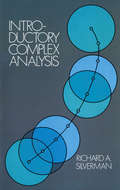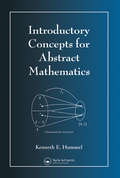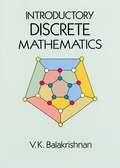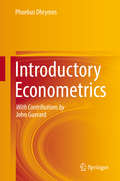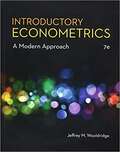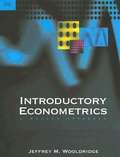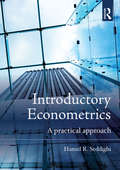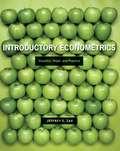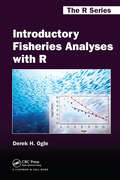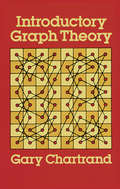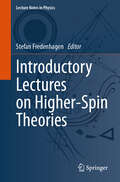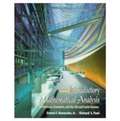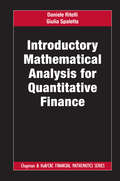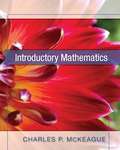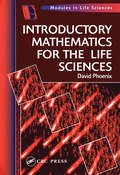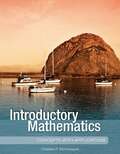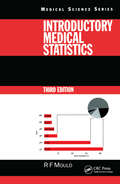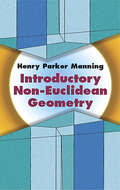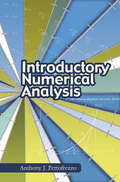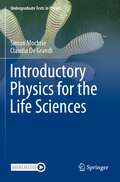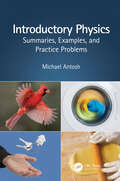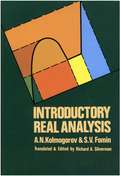- Table View
- List View
Introductory Complex Analysis (Dover Books on Mathematics)
by Richard A. SilvermanIntroductory Complex Analysis is a scaled-down version of A. I. Markushevich's masterly three-volume "Theory of Functions of a Complex Variable." Dr. Richard Silverman, the editor and translator of the original, has prepared this shorter version expressly to meet the needs of a one-year graduate or undergraduate course in complex analysis. In his selection and adaptation of the more elementary topics from the original larger work, he was guided by a brief course prepared by Markushevich himself.The book begins with fundamentals, with a definition of complex numbers, their geometric representation, their algebra, powers and roots of complex numbers, set theory as applied to complex analysis, and complex functions and sequences. The notions of proper and improper complex numbers and of infinity are fully and clearly explained, as is stereographic projection. Individual chapters then cover limits and continuity, differentiation of analytic functions, polynomials and rational functions, Mobius transformations with their circle-preserving property, exponentials and logarithms, complex integrals and the Cauchy theorem , complex series and uniform convergence, power series, Laurent series and singular points, the residue theorem and its implications, harmonic functions (a subject too often slighted in first courses in complex analysis), partial fraction expansions, conformal mapping, and analytic continuation.Elementary functions are given a more detailed treatment than is usual for a book at this level. Also, there is an extended discussion of the Schwarz-Christolfel transformation, which is particularly important for applications.There is a great abundance of worked-out examples, and over three hundred problems (some with hints and answers), making this an excellent textbook for classroom use as well as for independent study. A noteworthy feature is the fact that the parentage of this volume makes it possible for the student to pursue various advanced topics in more detail in the three-volume original, without the problem of having to adjust to a new terminology and notation .In this way, IntroductoryComplex Analysis serves as an introduction not only to the whole field of complex analysis, but also to the magnum opus of an important contemporary Russian mathematician.
Introductory Concepts for Abstract Mathematics
by Kenneth E. HummelBeyond calculus, the world of mathematics grows increasingly abstract and places new and challenging demands on those venturing into that realm. As the focus of calculus instruction has become increasingly computational, it leaves many students ill prepared for more advanced work that requires the ability to understand and construct proofs.Introductory Concepts for Abstract Mathematics helps readers bridge that gap. It teaches them to work with abstract ideas and develop a facility with definitions, theorems, and proofs. They learn logical principles, and to justify arguments not by what seems right, but by strict adherence to principles of logic and proven mathematical assertions - and they learn to write clearly in the language of mathematicsThe author achieves these goals through a methodical treatment of set theory, relations and functions, and number systems, from the natural to the real. He introduces topics not usually addressed at this level, including the remarkable concepts of infinite sets and transfinite cardinal numbersIntroductory Concepts for Abstract Mathematics takes readers into the world beyond calculus and ensures their voyage to that world is successful. It imparts a feeling for the beauty of mathematics and its internal harmony, and inspires an eagerness and increased enthusiasm for moving forward in the study of mathematics.
Introductory Discrete Mathematics (Dover Books on Computer Science)
by V. K BalakrishnanThis concise text offers an introduction to discrete mathematics for undergraduate students in computer science and mathematics. Mathematics educators consider it vital that their students be exposed to a course in discrete methods that introduces them to combinatorial mathematics and to algebraic and logical structures focusing on the interplay between computer science and mathematics. The present volume emphasizes combinatorics, graph theory with applications to some stand network optimization problems, and algorithms to solve these problems.Chapters 0-3 cover fundamental operations involving sets and the principle of mathematical induction, and standard combinatorial topics: basic counting principles, permutations, combinations, the inclusion-exclusion principle, generating functions, recurrence relations, and an introduction to the analysis of algorithms. Applications are emphasized wherever possible and more than 200 exercises at the ends of these chapters help students test their grasp of the material.Chapters 4 and 5 survey graphs and digraphs, including their connectedness properties, applications of graph coloring, and more, with stress on applications to coding and other related problems. Two important problems in network optimization - the minimal spanning tree problem and the shortest distance problem - are covered in the last two chapters. A very brief nontechnical exposition of the theory of computational complexity and NP-completeness is outlined in the appendix.
Introductory Econometrics
by Humberto Barreto Frank M. HowlandThis highly accessible and innovative text and accompanying CD-ROM use Excel (R) workbooks powered by Visual Basic macros to teach the core concepts of econometrics without advanced mathematics. It enables students to run Monte Carlo simulations in order to understand the data generating process and sampling distribution. Intelligent repetition of concrete examples effectively conveys the properties of the ordinary least squares (OLS) estimator and the nature of heteroskedasticity and autocorrelation. Coverage includes omitted variables, binary response models, basic time series, and simultaneous equations. The authors teach students how to construct their own real-world data sets drawn from the internet, which they can analyze with Excel (R) or with other econometric software. The Excel add-ins allow students to draw histograms, to compute P-values and robust standard errors, and to construct their own MonteCarlo and bootstrap simulations. For more readers may visit the web site at www. wabash. edu/econometrics.
Introductory Econometrics
by Phoebus DhrymesThis book has taken form over several years as a result of a number of courses taught at the University of Pennsylvania and at Columbia University and a series of lectures I have given at the International Monetary Fund. Indeed, I began writing down my notes systematically during the academic year 1972-1973 while at the University of California, Los Angeles. The diverse character of the audience, as well as my own conception of what an introductory and often terminal acquaintance with formal econometrics ought to encompass, have determined the style and content of this volume. The selection of topics and the level of discourse give sufficient variety so that the book can serve as the basis for several types of courses. As an example, a relatively elementary one-semester course can be based on Chapters one through five, omitting the appendices to these chapters and a few sections in some of the chapters so indicated. This would acquaint the student with the basic theory of the general linear model, some of the prob#65533; lems often encountered in empirical research, and some proposed solutions. For such a course, I should also recommend a brief excursion into Chapter seven (logit and pro bit analysis) in view of the increasing availability of data sets for which this type of analysis is more suitable than that based on the general linear model.
Introductory Econometrics for Finance
by Chris BrooksThis best-selling textbook addresses the need for an introduction to econometrics specifically written for finance students. Key features: · Thoroughly revised and updated, including two new chapters on panel data and limited dependent variable models · Problem-solving approach assumes no prior knowledge of econometrics emphasising intuition rather than formulae, giving students the skills and confidence to estimate and interpret models · Detailed examples and case studies from finance show students how techniques are applied in real research · Sample instructions and output from the popular computer package EViews enable students to implement models themselves and understand how to interpret results · Gives advice on planning and executing a project in empirical finance, preparing students for using econometrics in practice · Covers important modern topics such as time-series forecasting, volatility modelling, switching models and simulation methods · Thoroughly class-tested in leading finance schools
Introductory Econometrics: A Modern Approach (Mindtap Course List Series)
by Jeffrey M. WooldridgeGain an understanding of how econometrics can answer today's questions in business, policy evaluation and forecasting with Wooldridge's INTRODUCTORY ECONOMETRICS: A MODERN APPROACH, 7E. Unlike traditional texts, this book's practical, yet professional, approach demonstrates how econometrics has moved beyond a set of abstract tools to become genuinely useful for answering questions across a variety of disciplines. The author has organized the book's presentation around the type of data being analyzed with a systematic approach that only introduces assumptions as they are needed. This makes the material easier to understand and, ultimately, leads to better econometric practices. Packed with relevant applications, the text incorporates more than 100 data sets in different formats. Updates introduce the latest developments in the field, including the recent advances in the so-called 'causal effects' or 'treatment effects,' to provide a complete understanding of the impact and importance of econometrics today.
Introductory Econometrics: A Modern Approach (Third Edition)
by Jeffrey M. WooldridgeThe modern approach of this text recognizes that econometrics has moved from a specialized mathematical description of economics to an applied interpretation based on empirical research techniques. It bridges the gap between the mechanics of econometrics and modern applications of econometrics by employing a systematic approach motivated by the major problems facing applied researchers today. Throughout the text, the emphasis on examples gives a concrete reality to economic relationships and allows treatment of interesting policy questions in a realistic and accessible framework.
Introductory Econometrics: A Practical Approach
by Hamid SeddighiThis book constitutes the first serious attempt to explain the basics of econometrics and its applications in the clearest and simplest manner possible. Recognising the fact that a good level of mathematics is no longer a necessary prerequisite for economics/financial economics undergraduate and postgraduate programmes, it introduces this key subdivision of economics to an audience who might otherwise have been deterred by its complex nature.
Introductory Econometrics: Intuition, Proof, and Practice
by Jeffrey ZaxIntroductory Econometrics: Intuition, Proof, and Practice attempts to distill econometrics into a form that preserves its essence, but that is acceptable—and even appealing—to the student's intellectual palate. This book insists on rigor when it is essential, but it emphasizes intuition and seizes upon entertainment wherever possible. Introductory Econometrics is motivated by three beliefs. First, students are, perhaps despite themselves, interested in questions that only econometrics can answer. Second, through these answers, they can come to understand, appreciate, and even enjoy the enterprise of econometrics. Third, this text, which presents select innovations in presentation and practice, can provoke readers' interest and encourage the responsible and insightful application of econometric techniques. In particular, author Jeffrey S. Zax gives readers many opportunities to practice proofs—which are challenging, but which he has found to improve student comprehension. Learning from proofs gives readers an organic understanding of the message behind the numbers, a message that will benefit them as they come across statistics in their daily lives. An ideal core text for foundational econometrics courses, this book is appropriate for any student with a solid understanding of basic algebra—and a willingness to use that tool to investigate complicated issues.
Introductory Fisheries Analyses with R (Chapman & Hall/CRC The R Series #32)
by Derek H. OgleA How-To Guide for Conducting Common Fisheries-Related Analyses in R Introductory Fisheries Analyses with R provides detailed instructions on performing basic fisheries stock assessment analyses in the R environment. Accessible to practicing fisheries scientists as well as advanced undergraduate and graduate students, the book demonstrates the flexibility and power of R, offers insight into the reproducibility of script-based analyses, and shows how the use of R leads to more efficient and productive work in fisheries science. The first three chapters present a minimal introduction to the R environment that builds a foundation for the fisheries-specific analyses in the remainder of the book. These chapters help you become familiar with R for basic fisheries analyses and graphics. Subsequent chapters focus on methods to analyze age comparisons, age-length keys, size structure, weight-length relationships, condition, abundance (from capture-recapture and depletion data), mortality rates, individual growth, and the stock-recruit relationship. The fundamental statistical methods of linear regression, analysis of variance (ANOVA), and nonlinear regression are demonstrated within the contexts of these common fisheries analyses. For each analysis, the author completely explains the R functions and provides sufficient background information so that you can confidently implement each method. Web Resource The author’s website at http://derekogle.com/IFAR/ includes the data files and R code for each chapter, enabling you to reproduce the results in the book as well as create your own scripts. The site also offers supplemental code for more advanced analyses and practice exercises for every chapter.
Introductory Graph Theory
by Gary ChartrandGraph theory is used today in the physical sciences, social sciences, computer science, and other areas. Introductory Graph Theory presents a nontechnical introduction to this exciting field in a clear, lively, and informative style. Author Gary Chartrand covers the important elementary topics of graph theory and its applications. In addition, he presents a large variety of proofs designed to strengthen mathematical techniques and offers challenging opportunities to have fun with mathematics. Ten major topics -- profusely illustrated -- include: Mathematical Models, Elementary Concepts of Graph Theory, Transportation Problems, Connection Problems, Party Problems, Digraphs and Mathematical Models, Games and Puzzles, Graphs and Social Psychology, Planar Graphs and Coloring Problems, and Graphs and Other Mathematics. A useful Appendix covers Sets, Relations, Functions, and Proofs, and a section devoted to exercises -- with answers, hints, and solutions -- is especially valuable to anyone encountering graph theory for the first time. Undergraduate mathematics students at every level, puzzlists, and mathematical hobbyists will find well-organized coverage of the fundamentals of graph theory in this highly readable and thoroughly enjoyable book.
Introductory Lectures on Higher-Spin Theories (Lecture Notes in Physics #1028)
by Stefan FredenhagenThe book offers a pedagogical introduction to higher-spin gauge theories. These theories build upon fundamental gauge theories that are crucial for understanding core interactions. Electromagnetism and nuclear forces are associated with gauge fields of spin 1, while gravity can be conceptualized as a gauge theory of spin 2. This prompts the intriguing inquiry: do higher-spin gauge theories exist? Such theories would extend gravity, incorporating massless gauge fields of spins higher than two. They appear to bear connections to string theory and offer a captivating framework for exploring gravity and aspects of quantum gravity. The book initiates with a primer offering a comprehensive discussion on higher spins, delving into the challenges of establishing coherent interactions. It then explores methodologies to surmount these challenges within three-dimensional space-time. Furthermore, it investigates the emergence of asymptotic symmetry algebras, establishing links to a holographic dual conformal theory. The final chapter introduces Vasiliev’s approach to higher-spin gauge theory in four dimensions. Designed for advanced students and young researchers in theoretical physics and mathematical physics, the book aims to elucidate fundamental ideas, concepts, and tools underpinning higher-spin gauge theories. The inclusion of numerous exercises complements and illustrates the content, preparing readers for engagement with the subject's original literature and ongoing developments. To fully engage with the book's arguments, a prerequisite understanding of field theories and conventional gauge theories, including gravity, is assumed.
Introductory Mathematical Analysis for Business, Economics, and the Life and Social Sciences (Ninth Edition)
by Ernest F. Haeussler Richard S. PaulThis ninth edition of Introductory Mathematical Analysis continues to provide a mathematical foundation for students in business, economics, and the life and social sciences. It begins with noncalculus topics such as equations, functions, matrix algebra, linear programming, mathematics of finance, and probability. Then it progresses through both single-variable and multivariable calculus, including continuous random variables.
Introductory Mathematical Analysis for Quantitative Finance (Chapman and Hall/CRC Financial Mathematics Series)
by Daniele Ritelli Giulia SpalettaIntroductory Mathematical Analysis for Quantitative Finance is a textbook designed to enable students with little knowledge of mathematical analysis to fully engage with modern quantitative finance. A basic understanding of dimensional Calculus and Linear Algebra is assumed. The exposition of the topics is as concise as possible, since the chapters are intended to represent a preliminary contact with the mathematical concepts used in Quantitative Finance. The aim is that this book can be used as a basis for an intensive one-semester course. Features: Written with applications in mind, and maintaining mathematical rigor. Suitable for undergraduate or master's level students with an Economics or Management background. Complemented with various solved examples and exercises, to support the understanding of the subject.
Introductory Mathematics
by Charles P. Mckeague McKeagueThis textbook provides students with a solid foundation in basic mathematics, and an excellent preparation for algebra. The format, examples, and problems in this book have been refined through more than 20 years of classroom testing. As with all McKeague titles, his emphasis on study skills and his positive tone toward success are reflected in the presentation. Published by XYZ textbooks.
Introductory Mathematics for the Life Sciences (Modules In Life Science Ser.)
by David PhoenixIntroductory Mathematics for the Life Sciences offers a straightforward introduction to the mathematical principles needed for studies in the life sciences. Starting with the basics of numbers, fractions, ratios, and percentages, the author explains progressively more sophisticated concepts, from algebra, measurement, and scientific notation through the linear, power, exponential, and logarithmic functions to introductory statistics. Worked examples illustrate concepts, applications, and interpretations, and exercises at the end of each chapter help readers apply and practice the skills they develop. Answers to the exercises are posted at the end of the text.
Introductory Mathematics: Concepts with Applications
by Charles P. McKeague"This textbook provides students with a solid foundation in basic mathematics, and an excellent preparation for algebra. The format, examples, and problems in this book have been refined through more than 20 years of classroom testing. As with all McKeague titles, his emphasis on study skills and his positive tone toward success are reflected in the presentation."
Introductory Medical Statistics, 3rd edition
by Richard F. MouldIntroductory Medical Statistics, now in its third edition, is an introductory textbook on basic statistical techniques. It is written for physicians, surgeons, radiation oncologists, medical physicists, radiographers, hospital administrators, medical statisticians in training, biochemists, and other professionals allied to medicine. It is suitable
Introductory Modern Algebra
by Saul StahlPraise for the First Edition"Stahl offers the solvability of equations from the historical point of view...one of the best books available to support a one-semester introduction to abstract algebra."--CHOICEIntroductory Modern Algebra: A Historical Approach, Second Edition presents the evolution of algebra and provides readers with the opportunity to view modern algebra as a consistent movement from concrete problems to abstract principles. With a few pertinent excerpts from the writings of some of the greatest mathematicians, the Second Edition uniquely facilitates the understanding of pivotal algebraic ideas.The author provides a clear, precise, and accessible introduction to modern algebra and also helps to develop a more immediate and well-grounded understanding of how equations lead to permutation groups and what those groups can inform us about such diverse items as multivariate functions and the 15-puzzle. Featuring new sections on topics such as group homomorphisms, the RSA algorithm, complex conjugation, the factorization of real polynomials, and the fundamental theorem of algebra, the Second Edition also includes:An in-depth explanation of the principles and practices of modern algebra in terms of the historical development from the Renaissance solution of the cubic equation to Dedekind's idealsHistorical discussions integrated with the development of modern and abstract algebra in addition to many new explicit statements of theorems, definitions, and terminologyA new appendix on logic and proofs, sets, functions, and equivalence relationsOver 1,000 new examples and multi-level exercises at the end of each section and chapter as well as updated chapter summariesIntroductory Modern Algebra: A Historical Approach, Second Edition is an excellent textbook for upper-undergraduate courses in modern and abstract algebra.
Introductory Non-Euclidean Geometry (Dover Books on Mathematics)
by Henry Parker ManningThis fine and versatile introduction to non-Euclidean geometry is appropriate for both high-school and college classes. Its first two-thirds requires just a familiarity with plane and solid geometry and trigonometry, and calculus is employed only in the final part. It begins with the theorems common to Euclidean and non-Euclidean geometry, and then it addresses the specific differences that constitute elliptic and hyperbolic geometry. Major topics include hyperbolic geometry, single elliptic geometry, and analytic non-Euclidean geometry. 1901 edition.
Introductory Numerical Analysis
by Anthony J. PettofrezzoGeared toward undergraduate mathematics majors, engineering students, and future high school mathematics teachers, this text offers an understanding of the principles involved in numerical analysis. Its main theme is interpolation from the standpoint of finite differences, least squares theory, and harmonic analysis. Additional considerations include the numerical solutions of ordinary differential equations and approximations through Fourier series. Discussions of the relationships between the calculus of finite differences and the calculus of infinitesimals will prove especially important to future teachers of mathematics.More than seventy worked-out illustrative examples are featured; some include solutions by different methods, showing the relative merits of a variety of approaches. Over 280 multipart exercises range from drill problems to those requiring some degree of ingenuity on the part of the student. Answers are provided to problems with numerical solutions. The only prerequisites are a grasp of differential and integral calculus and some familiarity with determinants. An appendix containing definitions and several theorems from elementary determinant theory is included.
Introductory Physics for the Life Sciences (Undergraduate Texts in Physics)
by Simon Mochrie Claudia De GrandiThis classroom-tested textbook is an innovative, comprehensive, and forward-looking introductory undergraduate physics course. While it clearly explains physical principles and equips the student with a full range of quantitative tools and methods, the material is firmly grounded in biological relevance and is brought to life with plenty of biological examples throughout.It is designed to be a self-contained text for a two-semester sequence of introductory physics for biology and premedical students, covering kinematics and Newton’s laws, energy, probability, diffusion, rates of change, statistical mechanics, fluids, vibrations, waves, electromagnetism, and optics. Each chapter begins with learning goals, and concludes with a summary of core competencies, allowing for seamless incorporation into the classroom. In addition, each chapter is replete with a wide selection of creative and often surprising examples, activities, computational tasks, and exercises, many of which are inspired by current research topics, making cutting-edge biological physics accessible to the student.
Introductory Physics: Summaries, Examples, and Practice Problems
by Michael AntoshPhysics describes how motion works in everyday life. Clothes washers and rolling pins are undergoing rotational motion. A flying bird uses forces. Tossing a set of keys involves equations that describe motion (kinematics). Two people bumping into each other while cooking in a kitchen involves linear momentum. This textbook covers topics related to units, kinematics, forces, energy, momentum, circular and rotational motion, Newton’s general equation for gravity, and simple harmonic motion (things that go back and forth). A math review is also included, with a focus on algebra and trigonometry. The goal of this textbook is to present a clear introduction to these topics, in small pieces, with examples that readers can relate to. Each topic comes with a short summary, a fully solved example, and practice problems. Full solutions are included for over 400 problems. This book is a very useful study guide for students in introductory physics courses, including high school and college students in an algebra-based introductory physics course and even students in an introductory calculus-level course. It can also be used as a standalone textbook in courses where derivations are not emphasized.
Introductory Real Analysis
by Richard A. Silverman S. V. Fomin A. N. KolmogorovThis volume in Richard Silverman's exceptional series of translations of Russian works in the mathematical science is a comprehensive, elementary introduction to real and functional analysis by two faculty members from Moscow University. It is self-contained, evenly paced, eminently readable, and readily accessible to those with adequate preparation in advanced calculus.The first four chapters present basic concepts and introductory principles in set theory, metric spaces, topological spaces, and linear spaces. The next two chapters consider linear functionals and linear operators, with detailed discussions of continuous linear functionals, the conjugate space, the weak topology and weak convergence, generalized functions, basic concepts of linear operators, inverse and adjoint operators, and completely continuous operators. The final four chapters cover measure, integration, differentiation, and more on integration. Special attention is here given to the Lebesque integral, Fubini's theorem, and the Stieltjes integral. Each individual section -- there are 37 in all -- is equipped with a problem set, making a total of some 350 problems, all carefully selected and matched.With these problems and the clear exposition, this book is useful for self-study or for the classroom -- it is basic one-year course in real analysis. Dr. Silverman is a former member of the Institute of Mathematical Sciences of New York University and the Lincoln Library of M.I.T. Along with his translation, he has revised the text with numerous pedagogical and mathematical improvements and restyled the language so that it is even more readable.
